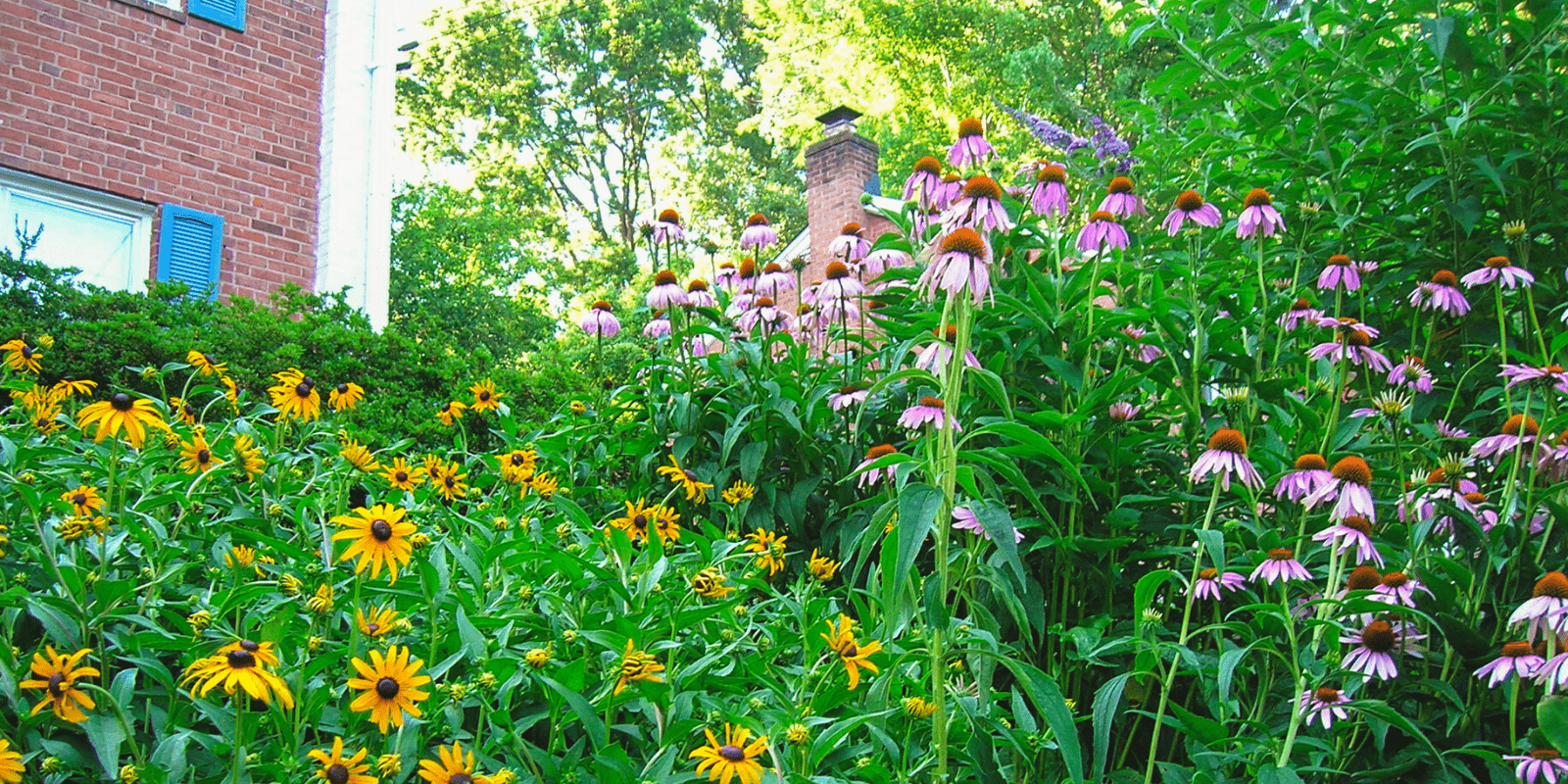We have much more to do and your continued support is needed now more than ever.
6 Actions to Combat Climate Change and Help Wildlife in Your Garden

We all care about the plant and animal communities in our gardens and landscapes. What you may not know is there are simple yet consequential things you can do in your yard and garden now to combat climate change while also making it wildlife-friendly.
Thank you in advance to my fellow gardeners for being both stewards and guardians of our environment by taking one or more of the actions below.
1. Less Lawn, More Native Plants
Maintaining a turfgrass lawn requires mowing (gas-powered mowers churn out carbon pollution) and fertilizers and pesticides (either fossil-fuel based or produced with fossil fuels) that harm our climate. Remove a chunk of your lawn and replace it with native plants (which do not need mowing or fertilizers and pesticides). Choose non-hybrid, “straight native” species, which are crucial for butterflies and native bees and ensure food sources for an array of local wildlife. While you’re at it, remove invasive plants in your yard to help minimize the threat of invasive species which choke out our native fauna that provide habitat and food for wildlife. Buy your native plants from a nursery that is following CDC guidelines for safe shopping procedures or order online from native plant distributors.
2. Plant or Foster Native Trees to Absorb Climate-Driving Carbon Pollution
A typical hardwood tree can absorb as much as 48 pounds of carbon dioxide pollution from the atmosphere a year. How? By absorbing and storing it in its trunk, branches, leaves, and roots. The best trees for carbon dioxide absorption have large trunks and dense wood. Climate fighting champions include native oak trees which are also champions for local wildlife: a native oak tree can support the caterpillars of over 500 species of butterflies and moths. Those caterpillars in turn are a critical food source for over 96 percent of the songbirds. Native pines are also a good choice. If you don’t have room for a tree or do not have a yard, you still can help. Put a small native tree in a pot next to your front door or on your balcony or “foster” a native deciduous tree in a container for a few years and then donate for planting in a community open space or park.
3. Grow Some Fruits, Vegetables, and Herbs
By growing even a few fruits, vegetables, and herbs organically at home, you’ll reduce your carbon footprint. Scientists from the University of California Santa Barbara found that greenhouse gas emissions can be reduced with homegrown vegetables compared to store-bought vegetables. Growing food at home using organic methods results in less packaging, less food traveled across the country and potentially fewer trips to the store—resulting in a reduction in the expenditure of energy and burning of climate-harming fossil fuels. Throw in a few edibles that are native to your region—think blueberries, cranberries, blackberries, pawpaws, squash, grapes, plums, black cherries, blue shrub sage—and you’ll help provide host plants, nectar and food for native bees, butterflies and other local wildlife.
4. Toss the Gasoline-powered Lawn Tools
Stop using gasoline-powered tools such as lawn mowers, trimmers, shrub shearers, and leaf blowers. These are major emitters of carbon dioxide, the primary global warming gas. Using a gasoline-powered mower for an hour pollutes the climate 11 times more than driving an average car for an hour. The noise from these machines can cause health problems for both people and wildlife. Some bird species are sensitive to noise levels during breeding season and studies have shown that loud noise causes caterpillar’s hearts to beat faster. Try electric or human-powered tools such as push mowers on your newly reduced area of lawn, prune with hand clippers rather than shearing shrubs, and use rakes or just leave some of the leaves.
5. Eliminate Chemical Fertilizers and Pesticides
Many of us already know that chemical pesticides in the garden can be deadly for wildlife, especially our native bees, butterflies and beneficial insects. But chemical applications for gardening also come with a climate-harming price tag. Synthetic nitrogen fertilizers and chemical pesticides are made by burning fossil fuels which spew carbon pollution into the air. Fertilizer runoff not only pollutes waterways and threatens crucial wildlife habitat but, as it breaks down, can also add to air pollution. Stop using anything synthetic in your garden. Your native plants don’t need added fertilizer. Utilize natural, untreated leaf mulch or pine fines if mulch is needed, organic fertilizers and natural methods for controlling pests.
6. Outdoor Energy Efficiency: Turn Off or Just Get Rid of Unneeded Lighting
First, inventory every one of your outdoor lights (including decoratives like string lights) to see which you can do without and remove them. For the remaining outdoor lights, turn them off when you go to bed or use a timer to reduce energy consumption that contributes to carbon pollution and make sure all lights are fully shielded to protect the night sky. Nighttime light pollution can seriously disorient migratory birds flying overhead and destroys habitat for fireflies. I removed the outdoor lamp post in my front yard, never miss it and am happy to give back some nighttime habitat that local wildlife depend on.
Share Your Garden
Please join us in celebrating climate gardening by sharing photos of your climate and wildlife-friendly garden on social media and helping friends and family safeguard the environment by sharing this blog post with them!





















